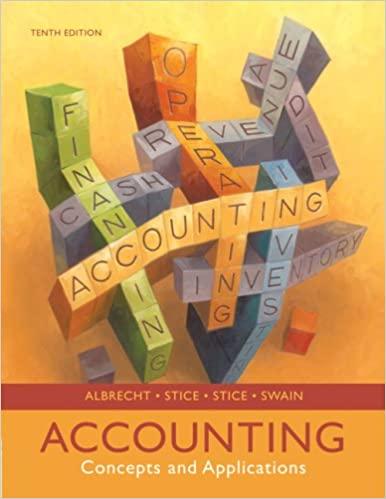Answered step by step
Verified Expert Solution
Question
1 Approved Answer
ACC 2230: Managerial Accounting 16e (Garrison et al) Homework 3 2. Lumbar Company manufactures and sells specialized electronics for high radiation environments. The company's contribution


ACC 2230: Managerial Accounting 16e (Garrison et al) Homework 3 2. Lumbar Company manufactures and sells specialized electronics for high radiation environments. The company's contribution format income statement for the most recent year is given below: % of Sales 100% Sales (20,000 units) Variable Expenses Contribution Margin Fixed Expenses Net Operating Income ?% Total $1,600,000 1.200,000 400,000 340,000 $ 60,000 Per Unit $80 60 $20 ?% Management is anxious to increase the company's profit and has asked for an analysis of a number of items. Required: A. Compute the company's CM ratio and variable expense ratio (4 pts) B. Compute the company's break-even point in both unit sales and dollar sales. Use the equation Method (4 pts) C. Assume that sales increase by $400,000 next year. If cost behavior patterns remain unchanged, by how much will the company's net operating income increase? Use the CM ratio to compute your answer (2 pts) D. Refer to the original data. Assume that next year management wants the company to earn a profit of at least $90,000. How many units will have to be sold to earn this target profit? (6 pts) E. Refer to the original data. Compute the company's margin of safety in both dollar and percentage Form (4 pts) F. (i) Compute the company's degree of operating leverage at the present level of sales (2 pts) (ii) Assume that through a more intense effort by the sales staff, the company's sales increase by 8% next year. By what percentage would you expect net operating income to increase? (2 pts) Use the degree of operating leverage to obtain your answer. (iii) Verify your answer to (b) by preparing a new contribution format income statement showing an 8% increase in sales (4 pts) 3. Mabel Company has no beginning and ending inventories, and reports the following information about its only product: Direct materials used Direct labor Variable indirect production Fixed indirect production Variable selling and administrative expenses Fixed selling and administrative expenses $29,000 $17,000 $13,000 $18,000 $22,000 $11,000 Units produced and sold Selling price per unit 10,000 $25 Required: A) Prepare an income statement using the contribution approach. (12 pts) B) Prepare an income statement using the absorption approach. (9 pts) TIL O costs equals the full cost of a product. 13. The total of all production costs plus the total of all A) selling B) distribution C) distribution and marketing D) selling and administrative 14. Frequently, companies do not use a contribution approach to pricing because A) it promotes price stability B) it provides the best defense for legal challenges C) of a fear of underpricing products by using variable costs to price products D) it is not sensitive to cost-volume-profit relationships 15. Which of the following is an advantage of the absorption approach to pricing products? A) It displays variable and fixed cost behavior patterns. ACC 2230: Managerial Accounting 16e (Garrison et al) Homework 3 B) It offers insights into the long run and short run effects of cutting prices on special orders. C) It can easily address changes in sales volume. D) It recovers all costs necessary for a firm to stay in business. B. TRUE/FALSE QUESTIONS (1 pt each) 1. Traditional cost systems allocate a cost pool to cost objects using multiple cost drivers. 2. Markup is the amount by which cost exceeds price. 3. In the short run, the sales price of a good or service must be high enough to cover all costs. 4. In the short run, when managers set prices for products, the minimum selling price should be equal to all variable costs of producing, selling and distributing the good or service 5. Marginal cost is the additional cost resulting from producing and selling one additional unit. C. PROBLEMS (65 pts) 1.. Activity-based costing is used for the manufacturing division of an automobile company. The company has identified three activities and the related cost drivers for indirect production costs. Activity Activity 1 Activity 2 Activity 3 Cost Driver Direct materials cost Direct labor cost Kilowatt hours Three types of products are produced. Direct costs and cost-driver activity for each product for a month are as follows: Direct materials cost Direct labor cost Direct labor hours Kilowatt hours Product A $75,000 $6,000 2,000 150,000 Product B $50,000 $1,000 1,000 200,000 Product C $125,000 $3,000 2,000 150,000 Indirect production costs for the month are as follows: Activity 1 Activity 2 Activity 3 Total $30,000 20,000 16,000 $66.000 Required: Assume indirect production costs are allocated to each product using the cost driver: direct labor hours. A) Compute the indirect production costs allocated to each product using the ABC system. (12 pts) B) Compute the indirect production costs allocated to each product using a traditional system (4 pts)
Step by Step Solution
There are 3 Steps involved in it
Step: 1

Get Instant Access to Expert-Tailored Solutions
See step-by-step solutions with expert insights and AI powered tools for academic success
Step: 2

Step: 3

Ace Your Homework with AI
Get the answers you need in no time with our AI-driven, step-by-step assistance
Get Started


